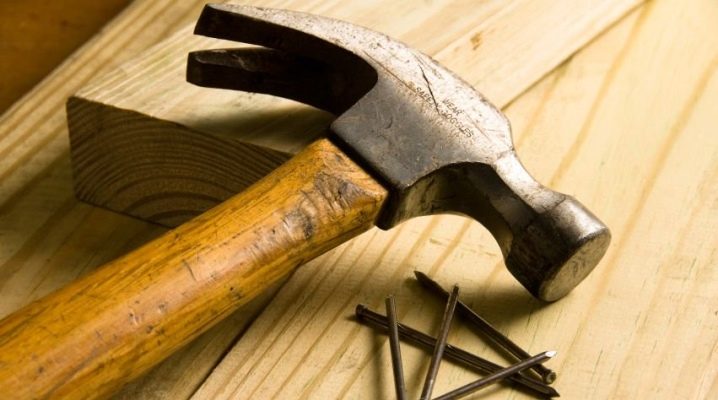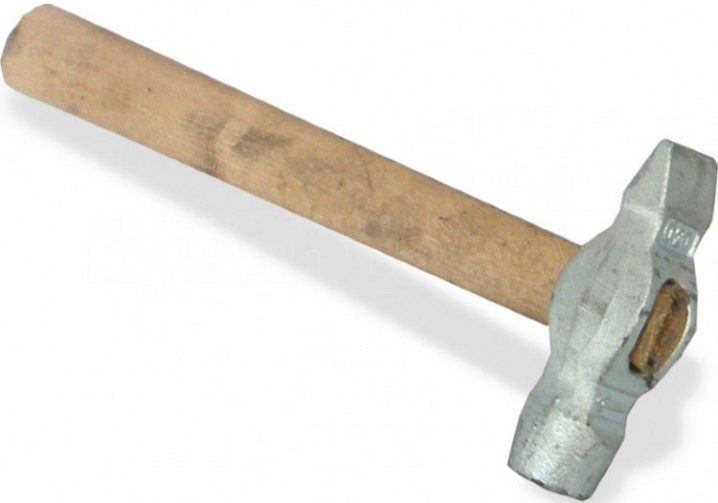Features of carpenter hammers

The profession of a carpenter has been known for a long time. Carpenters were directly involved in various works where there was a need for woodworking. Nowadays, the profession has not lost its relevance. The global mechanization and automation of manual labor had almost no effect on the work of carpenters. To help woodworking specialists, pneumatic and power tools were created. The most commonly used hand tool - the carpenter's hammer - has changed somewhat, but its essence remains the same.

Hammer
The classic hammer is a small hand-held hammer type tool. Consists of two main parts: striker and handle. The first is tightly fitted to the second.
The striker is made of a monolithic dense material that can withstand deformation from constant impacts. Only metal can withstand such loads.

The handle helps to swing well. As a rule, the handle is made of hardwood: ash, oak, hazel, birch or maple. There are tools that are completely metal and one-piece, as well as models with a steel drum and a plastic handle.

GOST 11042-90 regulates the following tool parameters:
- the weight;
- the size;
- type of.

The multifunctional carpenter's hammer differs from others in the shape of the striker. One side is for driving and leveling nails, the other for removing them.
Features of hammers with a nail puller
The carpentry hammer is distinguished by the fact that it is combined with the nail puller into one whole. The most comfortable models are with a wooden handle. The wood is capable of absorbing shocks, so the wood handle is the most comfortable to work with.

The carpenter does not have to do with one tool. In his arsenal there should be several types of hand tools. The differences are in the shape of the percussion part and are:
- flat;
- convex;
- corrugated.

The former are used for driving nails and wedges. The second is for working with other tools, for example, with a core or chisel. Still others are used to prevent slipping when hitting.
The opposite side of the striker is flattened and bifurcated. Thanks to the tapering slot, the so-called dovetail, the worker can remove nails with different caps: from small, several millimeters, to large ones exceeding a centimeter.

The flat part of the nailer can be straight or bent in the form of a hook. The hook extends the functionality of the tool.
The new generation professional hammer is endowed with the ability to keep nails from falling, which is very convenient when working with one hand. The steel fastener "sticks" to the tool due to the magnetized part of the striker. Often, special guiding recesses are equipped for a nail in the body of a percussion instrument.

Choosing a carpentry hammer with a wooden handle
The good thing about the all-metal hammer is that you don't have to push the head onto the handle. It is perfectly balanced and ready to go. The steel handle is uncomfortable when hitting. It can slip out of your hand. In addition, metal cannot dampen vibrations. Disadvantages are eliminated by applying impact-resistant plastic or thermoplastic rubber pads to the handle. So the hammer is securely held in the palm of the hand during work and protects the hand from shock loads.

The metal and plastic handles are undoubtedly strong enough.However, the hammer is constantly exposed to significant loads both when hammering in nails and when dismantling. The handles are tested for durability during the operation of the nailer. A new tool will age and become unusable over time.

The situation is somewhat different with wooden handles. At first, well-processed wood is just as reliable as metal. The wood, which is warm to the touch, does not require additional linings; it fits comfortably in the hand of the carpenter. When working with a tool with a wooden handle, the joints of the worker are maximally protected from vibration effects.

The tree itself dampens blows, as if absorbing them. Hands do not get as tired as when working with metal, plastic and other new materials used by manufacturers.

A broken wooden element is easy, unlike a steel one, to be replaced with a new one without damaging the tool. Fitting a new handle takes a minimum of time.
Another argument for a wooden handled hammer is its low cost. For Russian craftsmen, wood is more familiar than plastic and metal. Therefore, if you need to choose, they give preference to the tools that their distant and not very distant ancestors worked with.
Choosing a hammer
When choosing a carpentry hammer, you must first of all pay attention to its balancing. The tool must lie securely in the hand, not fall out of it and not rotate. Otherwise, close to injury, incorrect entry of nails into the body, their curvature upon impact. A nail driven in at an angle will not ensure the reliability of the fastening of the structure.

The hammer should be taken in hand, feel the weight. Standard tools weigh between 300 and 800 grams. It is worth taking such a model, which will be convenient to work without much stress. The most acceptable weight is considered to be 500-600 grams. The hand will not get too tired from a half-kilogram hammer.
It is also important to have an appropriate anti-corrosion treatment on the striker. The hammers work in a variety of conditions, including those with high humidity. Metal is susceptible to rust. Painting or other protection will help extend the life of the steel part of the tool.
It should not be forgotten that a good carpenter cannot do with one hammer. A specialist always has in his stock a whole set of tools that allows him to successfully perform work of varying complexity.

For more on the features of carpenter hammers, see the video below.













The comment was sent successfully.